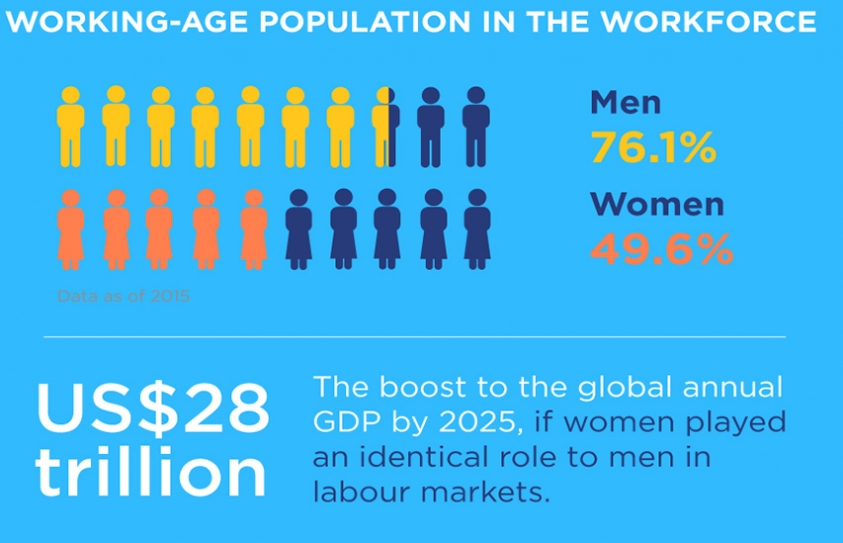“Historic imbalances in power relations between men and women, exacerbated by growing inequalities within and between societies and countries, are leading to greater discrimination against women and girls. Around the world, tradition, cultural values and religion are being misused to curtail women’s rights, to entrench sexism and defend misogynistic practices.”
Antonio Guterres, U.N Secretary General, March 6, 2017
The theme for Women’s Day 2017 is - ‘Women in the Changing World of Work: Planet 50-50 by 2030’. To get an idea of what the world of work is like for women in my immediate proximity, as a dipstick into the issue, I decided to ask three women from my immediate circle of friends, family and household help, about their work and lives, which, for most women, are entwined issues.
The following were their responses-
Parinita* - “I am 45 and have been married for 23 years. I have one daughter and one son, both of whom are in college. I have a postgraduate degree from one of the best universities in the country, but never made a career as i was brought up in a family where nurturing the home was considered a woman’s most important duty. Over the years, i got used to prioritising my husband and daughters. I was subjected to domestic violence very early in my marriage, but it took me many years before i could even admit to myself that it was a problem. Today, with my daughters on way to becoming independent, and a husband who does not care about me, I often wonder what I have done with my life. I feel low and depressed all the time.”
Ruby* - “I am 34 and a physiotherapist by profession. I had a part-time faculty position in the government college and a thriving private practice. I got married at 32, after many threats and showdowns from my educated parents. My husband was initially very supportive but later began complaining and criticising me as his mother and father were not happy with me for many reasons. I resigned from my job and cut down on my private practice, to devote more time at home- helping with cooking and housekeeping. My daughter was born within a year of my marriage. I was asked to stop working to give her all my attention. I resisted, but all such discussions would end up in violent episodes. One day, i decided that i could not take it anymore. I moved out of the house and into a one room kitchen apartment of my own. My husband has shown his disapproval by refusing to support even our daughter. I am struggling with balancing work, a house and a young child but do not wish to go back to that oppressive situation. I am contemplating filing for divorce.”
Sana*- “I am 28 years old and I work as a domestic help in three houses. I babysit a child of two in one house, cook lunch in another and do housecleaning in the third house. I earn enough to run my house in a tenement in Mumbai and send money to my parents in Kolkata who look after my two daughters who are 12 and 10 respectively, who go to school. My husband used to work as a driver of a school bus, but lost his job after he took to drinking. He is an alcoholic and does not work. He beats me up when i refuse to give him money. I have got an IUD inserted 3 years ago as i do not want to have any more children, but my husband has no knowledge of it. I don’t want to imagine how much he will beat me if he finds out. I live in dread of violence each day but i cannot think of living alone as it would be impossible in the society i come from. I think of my daughters and carry out my responsibilities.”
The issues that come forth are numerous and overwhelming to say the least. Work, for women, is connected to many things- social position as homemakers and nurturers, gender inequity, partial to total economic dependence in traditional societies, the burden of housework and other domestic unpaid labour, little or no autonomy in deciding their life plans, effects of alcohol and other addictions on their families, domestic violence, little or no control over their reproductive health needs.
All these are embedded in the social norms which encompass all socioeconomic strata. The privileges of being a woman in a patriarchal set-up where women are required to change their names (surnames and also first names in some communities), seem to be very few.
Some facts about Women in the Changing World Of Work-
(Source - UN Women website)
Labour force- Even as globalization has brought millions of women into paid labour, the number of women in the workforce is far behind that of men. Gender inequalities have also concentrated women at the bottom of the global value chain — in the lowest paid jobs, in piece-rate, subcontracted work, and insecure forms of self-employment, with little or no access to decent work and social protection.
Unemployment- Women are more likely to be unemployed than men worldwide, with wide disparities regionally
Occupational segregation - Women are concentrated in lower-paid, lower-skill work with greater job insecurity and under-represented in decision-making roles and fields such as science and technology. Today, half the global working population works in services, a sector where women dominate.
Wage gap- Globally, women only make 77 cents for every dollar earned by men for work of equal value. This is a major cause of lifetime income inequality. At current rates, it will take 70 years to close this gap.
Unpaid work- From cooking and cleaning, to fetching water and firewood or taking care of children and the elderly, women bear a disproportionate burden of unpaid work across the world. Unpaid work supports the economy and often fills in for lack of public expenditures on social services and infrastructure. In fact, unpaid care and domestic work is valued to be 10 and 39 per cent of the Gross Domestic Product.
Parental leave- While virtually every country in the world has adopted some form of maternity protection legislation, only 63 countries comply with minimum standards set out by the International Labour Organization of at least 14 weeks of paid maternity leave.
Informal work- Informal work can include those who are self-employed — such as street vendors, petty goods traders and subsistence farmers — as well as waged workers in domestic or seasonal agricultural work. One of the most vulnerable forms of informal employment is contributing family work. Globally, women comprise 63 percent of these workers, who are employed without direct pay in family businesses or farms.
Migrant workers- Migrants contribute to the economic and social wellbeing of societies both in their host and home countries. Globally, 57 per cent of domestic workers have no limitations on their working hours. A related concern is the trafficking of labour across borders: Migrants and young women are more likely to fall prey to unethical labour brokers, who through coercion and deceit expose them to precarious hiring arrangements and a number of other human and labour rights violations.
Violence against women- Violence against women in the world of work is a human rights violation that affects women regardless of age, location, income or social status. Violence against women can restrict women’s economic and social potential and have a significant impact on their physical and mental health, which can lead to absenteeism, missed promotions and job losses.
Legal Barriers- Barriers to gender equality persist in every country, in both private and public spheres, and are rooted in historically unequal power relations between women and men.Today, at least one gender-based legal restriction on women’s employment and entrepreneurship still exists in 155 countries*; husbands can legally prevent their wives from working in 18 countries*; and laws against gender discrimination in hiring practices are only in place in 67 countries
Social Protection- Women are overrepresented among the 73 per cent of the world’s population that has partial or no access to social protection, rendering them more vulnerable to poverty and other inequalities. Globally, nearly 65 per cent of people above retirement age without any regular pension are women.
This means that 200 million women in old age live without any regular income from social protection, compared to 115 million men.
Digital Divide- Gender inequalities that already exist for women are only mirrored, if not compounded, in the gig economy, which has mostly eluded labour protection and employment regulation.
As is evident by the facts above, the barriers and problems for women the world over, be they in the first or the third world, are very similar. Work is one more aspect which is affected by the existing social paradigms and influenced by social norms that prevent them from achieving their full potential. It is time we looked at work as a significant point on the list of issues that limit women’s progress, and took corrective steps which would serve as steps towards a more equitable world. .
References-
UN Secretary General’s Message for International Women’s Day
-http://www.unwomen.org/en/news/stories/2017/3/statement-sg-international-womens-day-2017#sthash.hgs3YLq3.dpuf
Women In the Changing World of Work- Facts You Should Know
http://interactive.unwomen.org/multimedia/infographic/changingworldofwork/en/index.html)
Official Website of the International Women’s Day
https://www.internationalwomensday.com/
International Women’s Day - 8 March
http://www.un.org/en/events/womensday/history.shtml
* Names have been changed to protect their identity





-173X130.jpg)
-173X130.jpg)
-173X130.jpg)
-173X130.jpg)
-173X130.jpg)

-173X130.jpg)
